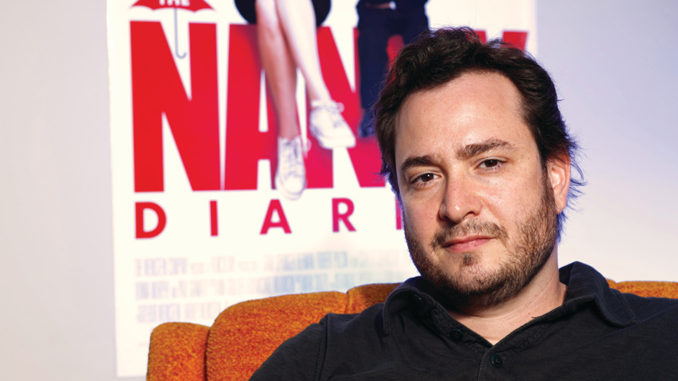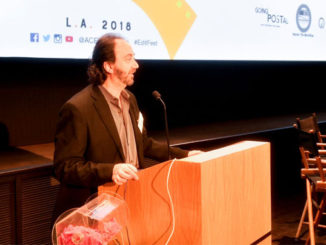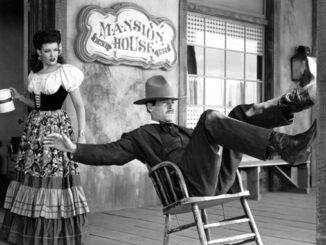
by Rob Feld • photo by Kfir Ziv
Husband and wife filmmaking team Robert Pulcini and Shari Springer Berman have been collaborating on short, documentary and narrative films together since their time at Columbia Film School. While they have shared the writing and directing hats on films like Off the Menu: The Last Days of Chasen’s (a documentary about the closing of Beverly Hills’ Chasen’s restaurant), The Young and the Dead (another doc on the rejuvenation of the Hollywood Forever cemetery), the hybrid doc American Splendor and now the narrative feature The Nanny Diaries (based on the novel of the same name by Emma McLaughlin and Nicola Kraus,) which opened August 24, Pulcini has donned an additional bit of headgear as editor. It has kept him busy––but also happy.
CineMontage recently visited Pulcini in his New York editing suite, where he was putting the finishing touches on The Nanny Diaries, to discuss his multi-tasking approach to filmmaking.
CineMontage: Was editing a skill that you deliberately developed in school?
Robert Pulcini: When I attended Columbia, you didn’t have to declare what your interests were. You were forced to take acting, editing, writing––everything. We were cutting on Steenbecks and for our first editing assignment, we were given all the dailies from an episode of Gunsmoke and told to construct an episode. This great documentary editor, Geoff Bartz, taught that course and he said that mine was the best Gunsmoke he’d ever seen.
I’d never done it before, but I started falling in love with the idea of being an editor, and ended up studying with Ralph Rosenblum, who edited so many great films, including Annie Hall. I edited Shari’s short and then other people’s work at Columbia, and completely fell in love with the process. At first, I didn’t have the confidence to edit Off the Menu, but out of necessity, I ended up doing it anyway and I was hooked. It’s the part of the process I love the most.
“When I’m editing, it’s all a creative high. I’m just so in love with the process, which is why I do it.” – Robert Pulcini
CM: Was it because it gives the most tactile sense of telling the story?
RP: I came to editing through documentaries and there’s nothing like that creative high you get when you start putting unrelated material together. It’s like the writing process; you have all this unrelated footage and you have to build these tiny bridges, connecting them somehow.
I’m so glad I had the opportunity to edit on Steenbeck. I edited Off the Menu in my apartment. At the time, Avid technology was still fairly new but a lot of people weren’t using Steenbecks, so I was able to get one very cheap. I actually had two in my apartment. I had the film everywhere. I do think you think differently when you edit on Steenbeck.
Avid certainly makes the editing easier, but I don’t know that it makes it better. I don’t know that you can speed up the time it takes to do the thinking part. I used to do a lot of thinking when my hands were busy, just pulling the rolls apart. I kind of miss it. The Young and the Dead was cut on Avid and it was the hardest thing I’d ever done in my life. Footage of a cemetery is not exactly action-packed. Once I got over that, I have no fear of anything anymore.
CM: What narrative device did you use to get through it?
RP: It was establishing these characters and combining talking heads with vérité footage. Off the Menu and The Young and the Dead were about places as character and the people that inhabit them. Off the Menu was far easier because there was so much happening in every corner of that restaurant, just coming at us, that it was like, “What do we shoot?” In the Young and the Dead, it was the opposite. We were in a cemetery. It was like, “What do we shoot?” There were tombstones, people coming to visit loved ones and whatnot. It took a lot longer and more planning for the story to unfold.
“I watch dailies like crazy and log it all in my brain. I watch them over and over––which is left over from documentaries, I think, because I want to feel like I know the footage by the time I sit down” – Robert Pulcini
CM: American Splendor was your first narrative. Did you approach it differently?
RP: We scripted the film kind of the way it unfolds. We had no idea what would happen when we turned the camera on Harvey Pekar for the documentary stuff, but we kind of knew the slots where we wanted the spots to appear in the script. We imagined, maybe, what would happen in those moments.
When I went to edit it, I approached it like a traditional narrative and left these place holders. When I really started going through the doc footage, building things and shaping them, I think the trickiest part was getting in and out of the documentary moments; what would let us in it and what would take us out––and how that would flow. That was very difficult. Maybe I would rearrange where the doc footage appeared, because it would be more logical to break the story there and address this part of Harvey in the documentary footage.
CM: You weren’t editing while shooting, were you?
RP: I jump into the editing seat when the shooting is done. Then, of course, Shari takes over as director when I’m in the editing room and whips me into shape. I think the fear with directors is that they’re going to make everything three hours long and be in love with everything––but I actually enjoy cutting.
CM: Is it important for you to have that outside perspective so that you don’t get totally myopic?
RP: It’s extremely important to have someone who can tell me during shooting whether or not I’m missing something, or if a scene can’t be cut because I’m missing an angle. I couldn’t do both simultaneously. It’s also important to have an objective set of eyes on the footage because I do know how I’m going to put it together and sometimes I’m pleasantly surprised by the sense she makes of the footage.
“Avid certainly makes the editing easier, but I don’t know that it makes it better… I used to do a lot of thinking when my hands were busy, just pulling the rolls apart. I kind of miss it.” – Robert Pulcini
CM: Do you watch dailies?
RP: I watch dailies like crazy and log it all in my brain. I watch them over and over––which is left over from documentaries, I think, because I want to feel like I know the footage by the time I sit down––so that everything moves quickly. I’m really stupid with a lot of things, but with footage, I have an almost photographic memory. If I watch it twice, I’ll remember almost everything––which makes it all move so much faster for me. I’ll remember takes, mistakes, expressions and happy accidents.
CM: Are you, in effect, editing it while you’re writing and does that make shooting more efficient because you know what you’re not going to need?
RP: I don’t really think about how the scene will be shot while we’re writing, but I find that one of the benefits of being both director and editor is that I know when I have enough takes on a performance to cut the performance that I want––without getting one perfect take. I tend to focus so much on performance that I lose track of whether things will cut perfectly, but I think I know much more quickly when a performance will work.
There could be a huge problem with a take, but I’ll know that there’s this one piece that will cut together with another take to make a beautiful scene. That’s where my editing skills really help on set. But I do find myself getting overwhelmed by screen direction and I rely heavily on great script supervisors.
“It’s extremely important to have someone who can tell me during shooting whether or not I’m missing something, or if a scene can’t be cut because I’m missing an angle. I couldn’t do both simultaneously.” – Robert Pulcini
CM: Do you have a favorite stage of production, where you feel more in control or where you’re really making the movie?
RP: Editing, by far. Writing is extremely painful. I write a lot but it’s like giving birth and really hard. You don’t have that block of marble yet. Shooting is such a pressure cooker; the experience changes every 15 minutes—sometimes it’s wonderful, sometimes it’s horrific.
But when I’m editing, it’s all a creative high. I’m just so in love with the process, which is why I do it. It’s not that I don’t think someone else would do a good job, I just don’t want to give it up. I love being with the footage, I love seeing what happens when you start cutting, I love the challenges and possibilities, and I love when there’s a problem. Sometimes when I’m editing, I can go for 12 hours and forget to eat.
CM: How do you and Shari collaborate through this whole process?
RP: We don’t sit down together to write, we switch off. I’ll write a few scenes then Shari will go over it and write a few scenes after. We’ve also developed a sense of what parts of a story one of us is particularly good at, so I’ll be like, “You should handle that,” or vice versa.
Directing is very difficult because that’s where you don’t agree much, and we have to let each other try things. Sometimes it’s difficult for actors because they get conflicting direction. But I tend to focus on the visuals and work with Terry Stacy, our DP, while Shari tends to work with the actors more.
When I start editing, she really takes over as the director. I cut things and present it to her, and she’s very hard on me. She tells me what’s working and what’s not working. Shari has an amazing sense of rhythm and timing. She immediately keys into problems and has great ideas on how to solve them. I tend to resist and there’s a lot of arguing—I get very attached to editing ideas. What’s frustrating for her is that I’ll argue against trying something and then she’ll be right––but I give her such a hard time before I’ll try it. That happens a lot.






